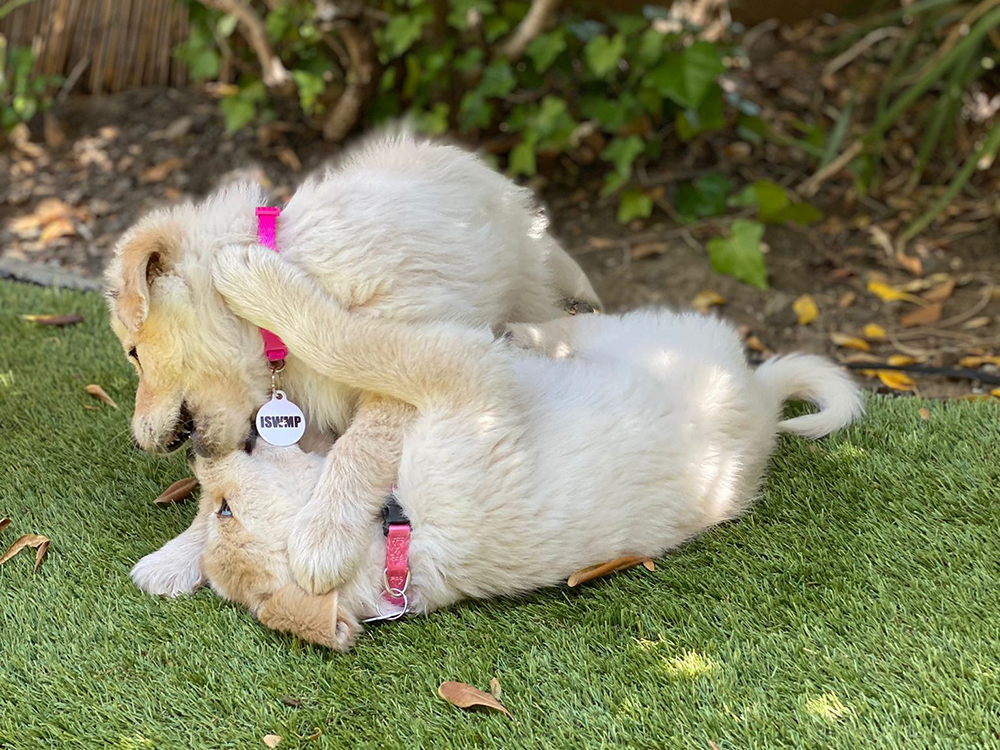Congratulations on bringing home the most adorable new family member. We are so excited for you!
The first few months of a puppy’s life are critical in determining what type of dog they will grow up to be. You can help your puppy evolve into an amazing canine companion by starting them off right and giving them the tools they need to be successful. This is especially important with our bully breed puppies as we have the responsibility to be ambassadors for these often misunderstood dogs. In order to help make the integration into your home as smooth as possible, here are some tips and recommendations for the first weeks with a new puppy.
Socialize, socialize, socialize!
Puppies that are well-socialized become well-adjusted adults. Socializing is just what it sounds like; it’s about getting your puppy out and about to experience new people, places, and situations. Many of the most common behavior concerns in dogs can stem from a lack of proper early socialization, like fear, aggression, and excessive barking. It’s important to get your puppy used to lots of different people, animals, places, sights, and sounds so he will not react poorly to them as an adult. In addition, your puppy needs to get used to being handled in different ways. Start helping your puppy get used to human touch; hold and touch his paws, look at his teeth, and praise him when he lets you. Give him a treat so he makes positive associations with being touched. This will help your puppy feel more comfortable at places like the vet and groomer.
(Of course, your new baby should not be out and about outside the home with other dogs and people until they are fully vaccinated. See the above vaccination schedule to keep your pup up-to-date on all vaccines.)

Potty Training
Potty training is one of the first things you will work on with your new puppy. The best place to start is with a regular schedule. Feed them at similar times each day. Take them outside to potty every time they eat, drink, or wake from a nap. Punishing a puppy for accidents in the house does not work; things like scolding or rubbing a pup’s nose in their mess will only scare or confuse them. The best way to house train a puppy is to reward them with praise, treats, and playtime when they go potty in the right spot. A crate can also be a helpful housebreaking tool as most dogs will not relieve themselves in the same place where they sleep. If your puppy is in the crate when they aren’t outside with you, or under your supervision in your house, you will be able to teach them when and where to go potty.
Crate Training
We highly recommend crate training! All puppies should be crated when they are left alone, so they don’t get into anything while you’re gone. A crate is used to confine a puppy when you are unable to supervise them and is not a punishment. In fact, if your puppy is given enough time to become comfortable in their crate, it can become one of their favorite spots. Crates can help prevent your puppy from developing bad habits like inappropriate chewing and are essential for potty training. A puppy shouldn’t be kept in their crate for more than a few hours at a time; however, they should not have the full run of the house! Always supervise your puppy closely and only give them access to areas where you can watch them.

Puppy Proofing
Puppies love to chew. Instead of trying to stop a puppy from chewing, teach them which things are appropriate chew toys. Again, crate training is one of the best tools you have when it comes to chewing; it stops your puppy from having the opportunity to chew on furniture, shoes, toys, or anything else you don’t want them to have. Redirecting them to appropriate toys is another part of chew training. It’s not enough to tell your dog “no” when they pick up something you don’t want them to have. Instead, you need to redirect them to something they can have, like a dog chew or a Kong.
Basic Training
All dogs respond better to positive reinforcement than to punishment. Punishment may stop unwanted behavior, but it does not tell your puppy what you want them to actually do. Harsh punishments may even lead to behavior issues like fear or aggression. Positive reinforcement makes your puppy want to do more of the things you want them to do. It’s quite easy to get your puppy to repeat the behaviors you like by rewarding them with praise, treats, and games. Ignore or redirect your puppy when they misbehave and reward good behavior. Soon, your puppy will be offering good behavior on a regular basis!Bite inhibition is another important part of puppy training. It involves teaching your puppy to use their teeth gently and that hands are not toys! Puppies begin to learn bite inhibition from their mothers and through play with littermates, but most puppies need to keep learning this once they go into a home. Begin teaching your puppy bite inhibition by allowing them to use their mouth when you are playing with them, but ending the playtime if they use their teeth too hard. Once your puppy learns that the fun stops when they bite too hard, you should begin to see them using their mouth much more gently. You may also try letting out a loud yelp sound to remind them to be careful. Bite inhibition is important because it keeps you safe from those needle-like puppy teeth. It also helps prevent a serious bite from occurring when your puppy grows into adulthood.
.
If you are ready to adopt, click here to learn more about our Adoption program.


